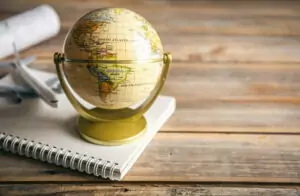Counting in German is not just a skill for mathematicians or market-goers—it’s a gateway into the heart of everyday life in Germany, Austria, and Switzerland. From ordering a round of beers to sharing your contact number, numbers are your constant companions in German-speaking lands.

✅ AI Essay Writer ✅ AI Detector ✅ Plagchecker ✅ Paraphraser
✅ Summarizer ✅ Citation Generator
Many assume that German is a labyrinthine language, but when it comes to numbers, it’s surprisingly straightforward. By learning the numbers from 1 to 20, you unlock a system that can carry you effortlessly up to 100. This article offers a clear and simple guide to counting in German, complete with pronunciation and examples.
German Numbers 1-10
The journey to German numerical fluency begins with the digits 0 through 10. These are the building blocks for all other numbers and are likely to be used daily. Here’s how to count from zero to ten in German:
| Number | German | Pronunciation | Example Sentence |
| 0 | null | nool | “Ich habe null Probleme.” (I have zero problems.) |
| 1 | eins | ayns | “Ich hätte gern eins Bier, bitte.” (I would like one beer, please.) |
| 2 | zwei | tsvy | “Wir brauchen zwei Tische.” (We need two tables.) |
| 3 | drei | dry | “Drei Personen haben angerufen.” (Three people called.) |
| 4 | vier | feer | “Vier Jahreszeiten sind wunderbar.” (Four seasons are wonderful.) |
| 5 | fünf | foonf | “Ich sehe fünf Vögel.” (I see five birds.) |
| 6 | sechs | zex | “Das Spiel hat sechs Level.” (The game has six levels.) |
| 7 | sieben | zee-ben | “Sie hat sieben Katzen.” (She has seven cats.) |
| 8 | acht | ahkht | “Acht Stunden Arbeit sind genug.” (Eight hours of work are enough.) |
| 9 | neun | noyn | “Ich habe neun Punkte erzielt.” (I scored nine points.) |
| 10 | zehn | tsehn | “Zehn Minuten bis zum Start.” (Ten minutes to start.) |
German Numbers 11-20
The numbers from 11 to 20 in German have their own unique forms, with “elf” and “zwölf” standing out as particularly distinct. Here’s your guide to counting from eleven to twenty:
| Number | German | Pronunciation | Example Sentence |
| 11 | elf | elf | “Ich komme um elf Uhr.” (I’ll come at eleven o’clock.) |
| 12 | zwölf | tsvölf | “Das Dutzend ist voll, zwölf Eier.” (The dozen is full, twelve eggs.) |
| 13 | dreizehn | dry-tsehn | “Mein Bruder ist dreizehn Jahre alt.” (My brother is thirteen years old.) |
| 14 | vierzehn | feer-tsehn | “Es sind vierzehn Grad draußen.” (It’s fourteen degrees outside.) |
| 15 | fünfzehn | foonf-tsehn | “Sie hat fünfzehn Bücher gelesen.” (She read fifteen books.) |
| 16 | sechzehn | zex-tsehn | “Ich habe sechzehn Euro gefunden.” (I found sixteen euros.) |
| 17 | siebzehn | zeeb-tsehn | “Meine Tasche wiegt siebzehn Kilo.” (My bag weighs seventeen kilos.) |
| 18 | achtzehn | ahkht-tsehn | “Er hat achtzehn Kilometer gelaufen.” (He ran eighteen kilometers.) |
| 19 | neunzehn | noyn-tsehn | “Ich warte schon neunzehn Minuten.” (I’ve been waiting nineteen minutes.) |
| 20 | zwanzig | tsvahn-tsig | “Das Haus hat zwanzig Fenster.” (The house has twenty windows.) |
German Multiples of 10
After 20, the numbers in German become more systematic. Learning the multiples of 10 is crucial, as they form the basis for the rest of the numbers up to 100.
| Number | German | Pronunciation | Example Sentence |
| 10 | zehn | tsehn | “Ich habe zehn Nachrichten bekommen.” (I received ten messages.) |
| 20 | zwanzig | tsvahn-tsig | “Ich bin in meinen Zwanzigern.” (I am in my twenties.) |
| 30 | dreißig | dry-sig | “Sie ist dreißig Jahre alt.” (She is thirty years old.) |
| 40 | vierzig | feer-tsig | “Es gibt vierzig Schüler in der Klasse.” (There are forty students in the class.) |
| 50 | fünfzig | foonf-tsig | “Mein Vater ist fünfzig Jahre alt.” (My father is fifty years old.) |
| 60 | sechzig | zex-tsig | “Das Buch hat sechzig Seiten.” (The book has sixty pages.) |
| 70 | siebzig | zeeb-tsig | “Die Reise kostet siebzig Euro.” (The trip costs seventy euros.) |
| 80 | achtzig | ahkht-tsig | “Meine Oma ist achtzig Jahre jung.” (My grandma is eighty years young.) |
| 90 | neunzig | noyn-tsig | “Es gibt neunzig Minuten in einem Fußballspiel.” (There are ninety minutes in a football match.) |
| 100 | hundert | hoohn-dert | “Ich lebe seit hundert Tagen hier.” (I have been living here for one hundred days.) |
How to Count from 1 to 100 in German
Once you’ve mastered the numbers up to 20 and the multiples of 10, you can form any number up to 100 by combining these elements. In German, the unit precedes the ten, joined by “und” (and).
Here’s how you can combine numbers to form higher numbers in German:
| German Number | Combination Example | Pronunciation |
| 21 | einundzwanzig | ayn-und-tsvahn-tsig |
| 32 | zweiunddreißig | tsvy-und-dry-sig |
| 47 | siebenundvierzig | zee-ben-und-feer-tsig |
| 58 | achtundfünfzig | ahkht-und-foonf-tsig |
| 69 | neunundsechzig | noyn-und-zex-tsig |
| 74 | vierundsiebzig | feer-und-zeeb-tsig |
| 85 | fünfundachtzig | foonf-und-ahkht-tsig |
| 96 | sechsundneunzig | zex-und-noyn-tsig |
By understanding this pattern, counting in German becomes intuitive. For example, 57 is “siebenundfünfzig” (seven-and-fifty), and 83 is “dreiundachtzig” (three-and-eighty). The pattern holds consistently, making it a simple task to learn to count all the way to 100. With this knowledge, you can confidently navigate markets, schedules, and social gatherings in German-speaking countries. So the next time you find yourself under the stars in a German town, counting “eins, zwei, drei” may lead you to dream in German too!
FAQ
Follow us on Reddit for more insights and updates.





Comments (0)
Welcome to A*Help comments!
We’re all about debate and discussion at A*Help.
We value the diverse opinions of users, so you may find points of view that you don’t agree with. And that’s cool. However, there are certain things we’re not OK with: attempts to manipulate our data in any way, for example, or the posting of discriminative, offensive, hateful, or disparaging material.